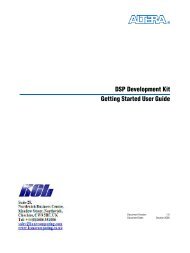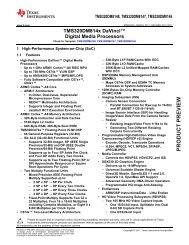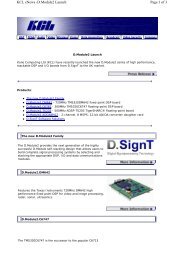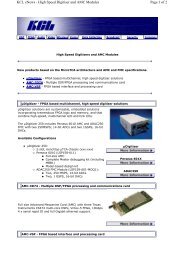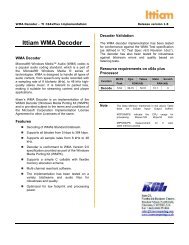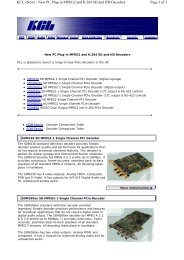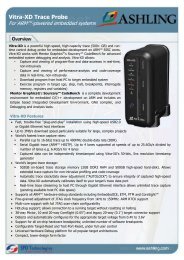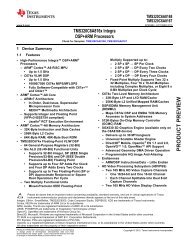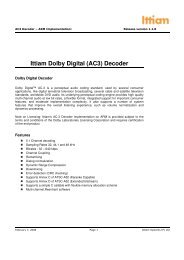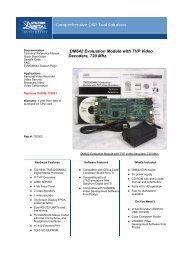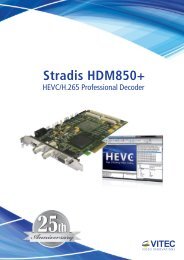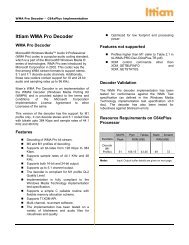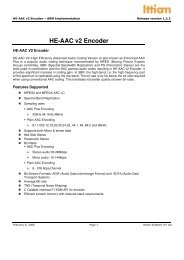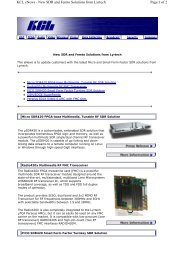OFDM Reference Design - Kane Computing Ltd
OFDM Reference Design - Kane Computing Ltd
OFDM Reference Design - Kane Computing Ltd
You also want an ePaper? Increase the reach of your titles
YUMPU automatically turns print PDFs into web optimized ePapers that Google loves.
Nutaq<br />
<strong>OFDM</strong> <strong>Reference</strong><br />
<strong>Design</strong><br />
FPGA-based, SISO/MIMO <strong>OFDM</strong> PHY Transceiver<br />
PRODUCT SHEET<br />
QUEBEC<br />
I MONTREAL I NEW YORK I<br />
nutaq<br />
.com
Nutaq <strong>OFDM</strong> <strong>Reference</strong> <strong>Design</strong><br />
• SISO/2x2 MIMO Implementation<br />
• Simulation/Implementation from the same<br />
source model<br />
• Model-based using Xilinx System Generator<br />
(Simulink models)<br />
• HD wireless video transmission case example<br />
• Up to QAM 64 modulation scheme<br />
• Modulation changes enabled at run-time<br />
• Included with Nutaq μSDR42x / Nutaq PicoSDR<br />
The Nutaq <strong>OFDM</strong> <strong>Reference</strong> <strong>Design</strong> is a complete<br />
SISO/MIMO <strong>OFDM</strong> PHY-layer implementation on Nutaq<br />
μSDR42x/PicoSDR Multimode tunable RF SDR Systems.<br />
The powerful Virtex-6 FPGA of the μSDR42x/PicoSDR<br />
kit (Perseus 601X) is used to implement the baseband<br />
<strong>OFDM</strong> modulator/demodulator. The tunable RF section<br />
(Radio420x), from its Zero-IF architecture, takes the<br />
digital-baseband <strong>OFDM</strong> modulated packets and brings<br />
their spectral content on a frequency range configurable<br />
from 300 MHz to 3 GHz. Demodulated data are exchanged<br />
with external host (Matlab) or embedded host (PPC/x86)<br />
for analysis and/or for the upper communication layers.<br />
An application showcases continuous wireless HD video<br />
transmission between two μSDR42x/PicoSDR system<br />
(or between RX and TX antennas of the same system).<br />
The Nutaq <strong>OFDM</strong> <strong>Reference</strong> <strong>Design</strong> is not compliant to a<br />
current telecommunication standard but is strongly based<br />
on the successful IEEE STD 802.11a (R2003) physical layer<br />
specifications. It features two different antenna schemes:<br />
Single Input Single Output (SISO) and Two-by-Two<br />
Multiple Input Multiple Outputs (2x2 MIMO). The MIMO<br />
capacity, enabled by the Radio420x Nutaq RF module,<br />
mitigates the effects of fading and results in improved<br />
bit error rate at the receiver.<br />
The baseband implementation exploits the high bandwidth<br />
capabilities of the FMC Radio420 by using 20 MHz of<br />
modulation bandwidth, which is an actual requirement<br />
for the next generation telecommunication standards,<br />
such as Long Term Evolution (LTE). Both the transmitter<br />
and the receiver can be implemented in a single FPGA<br />
(Perseus 601X), enabling a complete low-cost solution<br />
in a single board.<br />
RF Channels<br />
(0.3 - 3 GHz)<br />
Virtex-6<br />
FPGAs<br />
Embedded<br />
Blade (x86/PPC)<br />
Storage<br />
System<br />
Synchronisation<br />
Remote<br />
PC (x86/PPC)<br />
μTCA Chassis
THE TRANSMITTER<br />
Using the RTDEx (Real-time Data Exchange Host FPGA) core of the Nutaq Perseus 601X, the compressed video data<br />
is fed from the host PC (using VLC software) and sent through the FPGA-based <strong>OFDM</strong> modulator. The following physical<br />
layer operations are performs before going over the air:<br />
Data Streaming<br />
from Host PC<br />
Parallel<br />
to Serial<br />
Data<br />
Scrambler<br />
Convolutional<br />
Coder<br />
QAM<br />
mapping<br />
Cyclic prefix/suffix<br />
insertion<br />
IFFT<br />
Pilots<br />
Insertion<br />
Space Time<br />
Block Coding<br />
Interpolation<br />
Filters<br />
I&Q data<br />
interleaving<br />
To FMC<br />
Radio420<br />
External Hardware Interaction<br />
The video stream bits are serialized and scrambled for Peak to Average Power Ratio (PAPR) reduction and then,<br />
convolutional coding is performed. The resulting bits are mapped using the Quadrature Amplitude Modulation (QAM)<br />
technique. The size of the constellation can be modified at run-time, depending on the actual signal quality and<br />
environment. If required, the Space-Time Block Coding (STBC) is performed using the Alamouti’s transmission scheme<br />
matrix. An <strong>OFDM</strong> training symbol for Block Boundary Detection (BBD) and coarse Carrier Frequency Offset estimation<br />
(CFO), followed by channel estimation pilots, are inserted in front of the payload. The Inverse Discrete Fourier Transform<br />
(IDFT) of the data is efficiently performed using the Inverse Fast Fourier Transform (IFFT) algorithm, provided by the<br />
System Generator block library. Cyclic prefix and suffix is inserted and each <strong>OFDM</strong> time symbols are routed to their<br />
respective antenna, if MIMO transmission scheme is required. An FIR filter interpolation is performed to match the<br />
40 MSPS sampling rate of the FMC Radio420 ADC’s, followed by I&Q interleavers, to match the ADC’s required<br />
data input mechanic.
THE RECEIVER<br />
In a free running manner, the FMC Radio420 digitizes and moves down the 20 MHz RF bandwidth to baseband. In the<br />
receiver, the following physical layer operations are performed on the received digitized samples:<br />
From FMC<br />
Radio420<br />
I&Q data<br />
deinterleaving<br />
CFO<br />
Correction<br />
Decimation<br />
Filters<br />
Automatic<br />
Gain Control<br />
Coarse CFO<br />
Estimation<br />
Channel<br />
Estimation<br />
FFT<br />
Cyclic Prefix<br />
Removal<br />
Block Boundary<br />
Detection<br />
Equalizer/Pilot<br />
Remover<br />
Space Time<br />
Block Decoder<br />
QAM<br />
Demapper<br />
Error<br />
Correction<br />
External Hardware Interaction<br />
Data Streaming<br />
to Host PC<br />
Data<br />
Descrambler<br />
In the Perseus 601X FPGA, the I&Q data are de-interleaved and filtered by a matched filter, for BBD purpose. When<br />
the BBD threshold is met, a coarse CFO estimation is made, using the same <strong>OFDM</strong> training symbol. A Direct Digital<br />
Synthesizer (DDS) frequency is configured on-the-fly by the provided CFO estimate and a complex multiplier is used<br />
to correct the offset. Using the BBD pulse signal, we can remove the cyclic prefixes and suffixes from the <strong>OFDM</strong><br />
packet and proceed to the Discrete Fourier Transform algorithm. Again, the DFT is implemented using an efficient<br />
FFT algorithm from the System Generator block library. Being now in the frequency domain, channel estimation<br />
is made using the received <strong>OFDM</strong> pilot symbols and the equalization is performed on the received <strong>OFDM</strong> payload<br />
symbols. Depending on the QAM constellation size, de-mapping is performed and the resulting QAM symbols<br />
are sent to the error correction block. Finally, the payload bits are descrambled and parallelized into 32 bits samples,<br />
for streaming over the Perseus 601X’s RTDEx interface, back to a host VLC (video player) application.
Nutaq <strong>OFDM</strong> <strong>Reference</strong> <strong>Design</strong><br />
Features<br />
NOW<br />
2013 ROADMAP<br />
Data Modulation QAM 64 QAM 4 / 16 / 64<br />
Data rates > 10 Mbps TBD<br />
Video streaming example HDTV HDTV<br />
SISO version Yes Yes<br />
Diversity scheme (2x2 MIMO) Yes Yes<br />
Channel Estimation Yes Yes<br />
Data Scrambler Yes Yes<br />
Carrier Frequency Offset Correction No Yes<br />
AGC No Yes<br />
Uplink – Downlink Downlink only Uplink & Downlink<br />
EEC scheme No Yes<br />
Data Interleaver No Yes<br />
QAM demapper Hard decision based Soft decision based<br />
FFT Size 64 64<br />
Bandwidth 20 MHz 20 MHz
Nutaq products are constantly being improved; therefore, Nutaq reserves itself the right to modify the information herein<br />
at any time and without notice. The FMC logo is a trademark of VITA.<br />
NUTAQ INC. ALL RIGHTS RESERVED • V 1.1—19/11/2012<br />
2150 Cyrille-Duquet, Quebec City (Quebec) G1N 2G3 CANADA<br />
T. 418-914-7484 | 1-855-914-7484 | F. 418-914-9477<br />
info@nutaq.com



